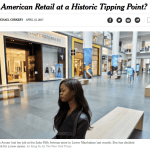 Sixty-nine percent of consumers plan to buy Mother’s Day flowers next month, in what could be a record-breaking holiday. In fact, consumers are expected to spend more money this year and seem more likely to head to a specialty store or small business to find their gifts.
Sixty-nine percent of consumers plan to buy Mother’s Day flowers next month, in what could be a record-breaking holiday. In fact, consumers are expected to spend more money this year and seem more likely to head to a specialty store or small business to find their gifts.
That’s the very good news from the National Retail Federation, which recently announced that Mother’s Day shoppers are expected to spend an average of $186.39 for the holiday, up from last year’s $172.22.
“With 85 percent of consumers surveyed celebrating the holiday, total spending is expected to reach $23.6 billion,” the group detailed. “That’s the highest number in the survey’s 14-year history, topping last year’s previous record of $21.4 billion.”
According to the NRF survey, consumers plan to spend $2.6 billion on flowers this year and 69 percent of shoppers intend to buy flowers. That’s an increase from 2016 when NRF predicted consumers would spend $2.4 billion on flowers (purchased by 66.5 percent of shoppers). NRF said 31 percent will shop at specialty stores such as florists, jewelers or electronics stores, compared to 28.7 percent in 2016, while 24 percent plan to shop at a local small business, up from 23.1 percent last year.
Floriculture research firm Prince & Prince Inc., shares the NRF’s optimistic take — and sees a promising shift among younger adults.
The group predicts that consumer floral spending for Mother’s Day will reach $4.2 billion at retail this year, up from $4 billion last year, including all fresh floral products (cut flower arrangements, bouquets, roses, single stems, and corsages, and indoor potted flowering and foliage plants and planters) and any associated delivery/ service fees. Prince & Prince also expects nearly 55 million households in the U.S. to purchase fresh flowers and/or potted plants on Mother’s Day, spending, on average slightly more than $76 per household. Those numbers are relatively stable, said Tom Prince, the group’s president, who added that growth in incidence of purchase is likely attributed to population growth.
Something that has changed? Younger people seem more likely to buy flowers for Mother’s Day, he said.
“Floral purchasing for Mother’s Day has been trending up over the past decade for householders under the age of 35, and those aged 35 to 44,” he said, noting that he projects 74 percent of households within those groups intend to buy flowers for Mother’s Day, an increase of 11 percentage points from 2007. “These two age groups now attain the highest likelihood of floral purchase for Mother’s Day of all age groups.”
Last year, 66 percent of florists who responded to a Society of American Florists post-holiday survey reported an increase in sales. Among those respondents, nearly a quarter said the rise was modest, somewhere between1 and 5 percent. About 37 percent of florists with those increased sales credited shop promotions for the uptick. Meanwhile, 20 percent of respondents saw a drop in sales — 53 percent said they weren’t sure how steep the decline was — and 14 percent said sales were flat.
The survey also found that average transactions hovered just below $64, slightly higher than returns in 2015.
What Consumers Will Buy
In addition to flowers, the NRF survey predicts consumers will spend $5 billion on jewelry (purchased by 36 percent of shoppers), $4.2 billion on special outings such as dinner or brunch (56 percent), $2.5 billion on gift cards (45 percent), $2.1 billion on clothing (37 percent), $2 billion on consumer electronics (15 percent) and $1.9 billion on personal services such as a spa day (24 percent). The overall increase is expected to be driven largely by spending on jewelry, which is up 19 percent, and personal services, up 15 percent.
Where They Will Shop
Beyond specialty stores and small businesses, this year’s survey found that 35 percent of consumers will head to department stores (compared to 33 percent in 2016) 30 percent will shop online, up from 27 percent last year. Among smartphone owners, 34 percent will research gift ideas on their phones while 19 percent will use them to make a purchase. That’s an increase over last year, when 29.6 percent said they would research gift ideas on their phones and15.5 percent said they’d use them to make a purchase.
Stay on Target
Among the group most likely to research and purchase gifts via mobile? Millennials, of course, and Prosper Principal Analyst Pam Goodfellow suggested consumers in the 25- to 34-year-old range are a covetable market to target in your Mother’s Day promos, a prediction that echoes data from the Prince & Prince findings.
“Consumers are planning to open up their wallets a little bit more to celebrate the women with the most important jobs in the world on Mother’s Day,” Goodfellow told NRF. “We will see older millennials (25-34) spend the most, and younger consumers are putting their online shopping skills to good use to purchase their moms the perfect gift.”





